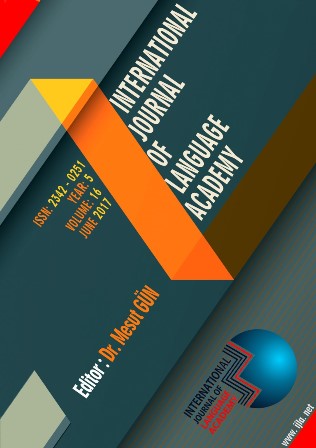Author :
Abstract
Virginia Woolf’un, Elizabeth Barrett Browning ve onun Spaniyel cinsi köpeği Flush’tan esinlenerek yazdığı kurgusal eseri Flush (1933), bir köpeğin bakış açısıyla Viktorya çağı değerlerinin eleştirel analizini yapar. Pek çok eserinde Woolf, Londra’yı detaylı bir şekilde tasvir eder ve kent hayatını ataerkil düzende bağımsızlıklarını elde etmeye çalışan kadınların mücadelelerini anlatmak amacıyla kullanır. Woolf’un eserlerinde Londra, arka planda duran işlevsiz bir dekor olarak değil roman karakterlerinden biri olarak göze çarpar. Flush, Virginia Woolf’un şehirlerde yaşayan kadınların toplumsal statülerine dair görüşlerini dile getirmek amacıyla Londra’yı bir karakter olarak yansıttığı eserlerinden biridir. Metinde Viktorya dönemi Londra’sı, kısıtlayıcı kuralları ve derinden hissedilen sınıf ayrımı nedeniyle eleştirilir. Londra dışında, romanda detaylı olarak incelenen iki şehir Floransa ve Pisa’dır. Özgürlükçü bir yapıya sahip bu iki İtalyan şehri, insanı tahakküm altına alan Londra’nın aksine, sınıf ayrımını ortadan kaldıran ve kadınların zihinsel kapasitelerini kullanmalarını teşvik eden bir yapıya sahiptir. Flush’ın Londra, Pisa ve Floransa’daki deneyimleri, bireyin kendisini geliştirmesine engel olan baskıcı unsurlara ve bunların nasıl bertaraf edileceğine dikkat çeker. Bu makalenin amacı, Virginia Woolf’un Viktorya çağı toplumunu eleştirmek ve onu daha özgürlükçü bir yapıya dönüştürmek amacıyla kent yaşamını nasıl yansıttığını incelemektir.
Keywords
Abstract
Inspired by Elizabeth Barrett Browning’s life and her cocker spaniel Flush, Virginia Woolf’s fictional work Flush (1933) engages with the critical analysis of Victorian values through the eyes of a dog. In most of her novels, Woolf provides detailed descriptions of London with its gardens, buildings, family houses, work places and inhabitants, and she uses urban setting as a means to express her vision of women and their struggles in attaining independence in a patriarchal society. Moreover, in her works, London stands out as a character rather than merely a background setting. Flush is one of these works in which Woolf primarily concentrates on the depiction of London as a character in order to suggest her views about the status of women living in the metropolis. Throughout the text, Victorian London is attacked for its restrictive qualities and deeply-felt class distinction. Apart from London, two cities described in the novel are the Italian cities Pisa and Florence, which, with their liberating atmosphere, remove class distinction and encourage women to use their intellectual capacities. They serve as a foil to the domineering London. Flush’s respective experiences in London, Pisa and Florence point out the constraining human engagements and the ways for surmounting these obstacles. The aim of this paper is to analyze how these cities are used by Woolf to attack Victorian society and substitute it with a more liberating milieu.
Keywords
- Augustine, J. (1991). From Topos to Anthropoid.The City as Character in Twentieth- Century Texts. In M. A. Caws, City Images: Perspectives from Literature, Philosophy, and Film (pp. 73-86). New York: Gordon and Breach.
- Balaev, Michelle (2008). Trends in Literary Trauma Theory.Mosaic: An Interdisciplinary Critical Journal. 41(2), pp. 149-166.
- Caughie, P. (1991). Flush and the Literary Canon: Oh Where Oh Where Has That Little Dog Gone? Tulsa Studies in Women's Literature, 10(1), pp. 47-66.
- Caughie, P. (2007). Postmodernist and Poststructuralist Approaches. In A. Snaith, Palgrave Advances in Virginia Woolf Studies (pp. 143-168). New York: Palgrave Macmillan.
- Flint, K. (2009). Introduction. In V. Woolf, Flush (pp. xii-xlix). New York: Oxford University Press.
- Squier, S. M. (1983). The London Scene: Gender and Class in Virginia Woolf's London. Twentieth Century Literature, 29(4), pp. 488-500.
- Squier, S. M. (1985). Virginia Woolf and London: The sexual politics of the city. London: The University of North Carolina Press.
- Squier, S. M. (1991). Virginia Woolf's London and the Feminist Revision of Modernism.In M. A. Caws, City Images: Perspectives From Literature, Philosophy, and Film (pp. 99119). New York: Gordon and Breach.
- Woolf, V. (1982). The Letters of Virginia Woolf: Volume Five 1932-1935. Orlando: Harvest.
- Woolf, V. (2000). The London Scene: Six Essays on London Scene. New York: Harper Collins.
- Woolf, V. (2005). A Room of One's Own. Orlando: Harcourt.
- Woolf, V. (2009). Flush. New York: Oxford University Press.





